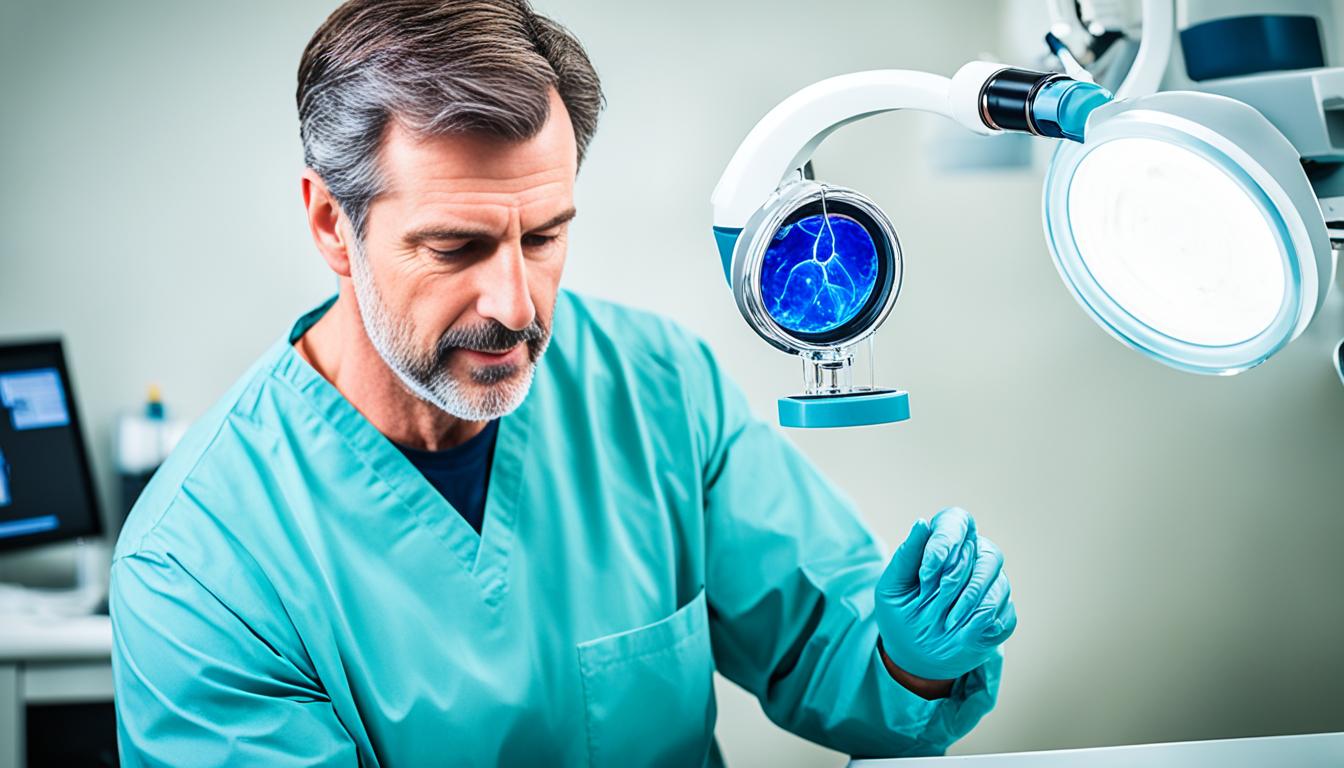Primary sclerosing cholangitis (PSC) is a chronic liver disease. It affects the biliary tree with inflammation, fibrosis, and duct stricture. The exact cause is not known, but it likely involves autoimmune, environmental, and ischemic factors.
People with PSC might feel tired, itchy, or have yellow eyes. Stomach pain is also possible but symptoms vary in how bad they are. Some may not experience them at all.
Diagnosis often uses imaging tests like ERCP or MRCP. These help doctors see the bile ducts and find issues like strictures.
Unfortunately, there’s no known cure for PSC yet. Doctors focus on easing symptoms and managing any complications. Treatments include medicine, changes to how you live, and sometimes surgery.
But, scientists are looking into how stem cell therapy might help. Stem cells could repair damaged liver parts, improving liver health. This might slow down or even stop the disease’s progress.
Key Takeaways:
- Primary sclerosing cholangitis (PSC) is a chronic liver disease characterized by chronic inflammation and stricturing of the bile ducts.
- PSC’s exact cause is unknown but is believed to involve autoimmune, environmental, and ischemic factors.
- Symptoms of PSC include fatigue, itching, jaundice, and abdominal pain.
- Diagnosis typically involves imaging tests like ERCP or MRCP.
- Currently, there is no curative medical treatment for PSC, but stem cell therapy shows promise as a potential breakthrough treatment.
Causes and Risk Factors of Primary Sclerosing Cholangitis
Primary sclerosing cholangitis (PSC) is a liver disease with a complex cause. It’s thought to come from a mix of genetic, environmental, and immune factors. These factors work together to make some people more likely to get PSC. Knowing about these causes helps us understand why some get PSC.
Genetic Factors
Genetics are very important in PSC’s development. People with family members who had PSC are more likely to get it. Certain genetic differences can put some people at higher risk. Yet, we don’t know all the specific genes involved.
Gender
Men face a higher risk of getting PSC than women. The reasons for this are not clear. This could be because of different hormone levels or immune responses in men. Other factors may also be at play here.
Autoimmune Diseases
It’s common for PSC to be linked with other autoimmune diseases like IBD. These include ulcerative colitis and Crohn’s disease. The shared immune issues in these conditions might explain their connection to PSC.
Environmental Factors
Exposure to certain toxins or infections might increase the risk of PSC. Yet, we’re still learning about the specific environmental causes. More research is needed to fully understand this aspect.
The causes of PSC are complex and not fully known. It’s likely a mix of genetic, immune, and environmental factors. We need further research to understand these aspects better. This could help us find new ways to detect, prevent, and treat PSC more effectively.
Symptoms, Diagnosis, and Management of Primary Sclerosing Cholangitis
Primary sclerosing cholangitis (PSC) brings a mix of symptoms that change from person to person. These may include tiredness, itching, yellow skin (jaundice), and stomach ache. They can hurt a lot and reduce how well someone can live.
Doctors use tests like ERCP and MRCP to look at the bile ducts and find problems. Blood tests and liver biopsies help confirm the condition. Finding PSC early and diagnosing it correctly are very important.
There is no cure for PSC, but treatment aims to ease symptoms and deal with problems that come up. Doctors might give medicines to reduce swelling and help with itching or pain. In serious cases where the bile ducts are blocked, procedures can help open them up.
Sometimes, a liver transplant is the last option if PSC gets very bad. A transplant can make life better and raises the chance of living longer for those with severe PSC.
People with PSC need to team up with their doctors to make a plan for care. This might mean regular check-ups, treating related conditions like IBD, and changing habits to keep the liver as healthy as possible.
Overview of PSC Management Approaches
| Management Approach | Description |
|---|---|
| Medications | Prescribed to control inflammation and manage symptoms such as itching or pain. |
| Bile Duct Procedures | Procedures like balloon dilation or stenting can relieve bile duct obstructions and improve bile flow. |
| Liver Transplantation | A viable treatment option for individuals with advanced PSC and end-stage liver disease. |
| Lifestyle Modifications | Adopting healthy habits such as maintaining a balanced diet, exercising regularly, and avoiding alcohol and certain medications that can harm the liver. |
Doctors aim to make the symptoms better and slow the disease down. They are also looking into new ways to treat PSC, like using stem cells. This method could fix the liver and cure PSC. But more research and tests are needed to prove if it’s safe and works well.
Breakthroughs in Stem Cell Therapy for Primary Sclerosing Cholangitis
Stem cell therapy is becoming a key player in treating primary sclerosing cholangitis (PSC). Its aim is to use the power of stem cells to repair the liver. This could stop or even turn around the disease. And, the first research results are quite hopeful.
This early research on stem cell therapy for PSC looks very promising, especially for patients who don’t get better with current treatments. This new method depends on stem cells’ ability to regenerate. It brings new hope to those fighting against PSC.
But, we must realize, more studies and tests are needed. We need to fully understand how safe and effective this therapy really is. These checks will help confirm if this new treatment is a good choice for PSC patients.

